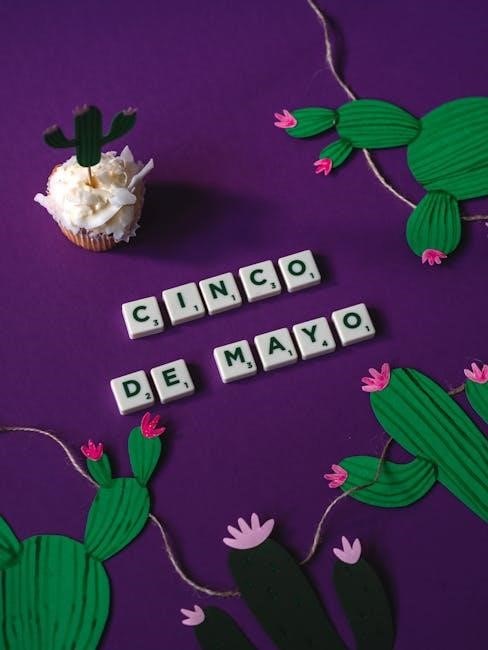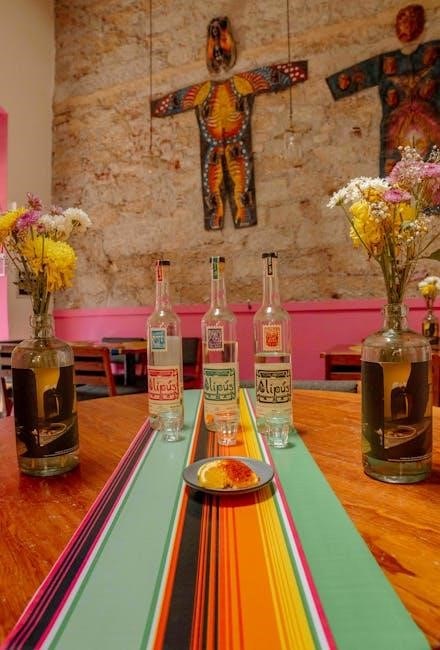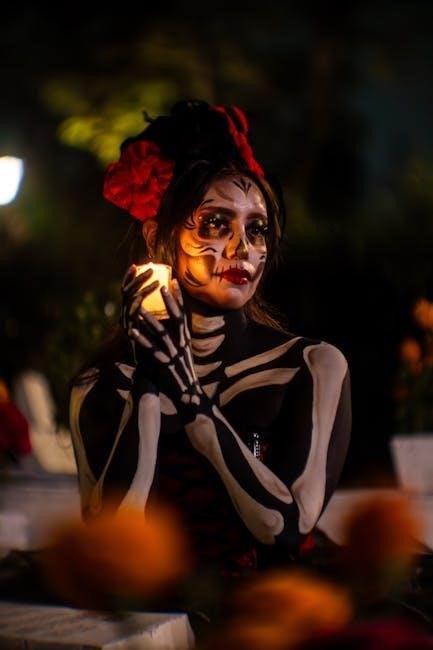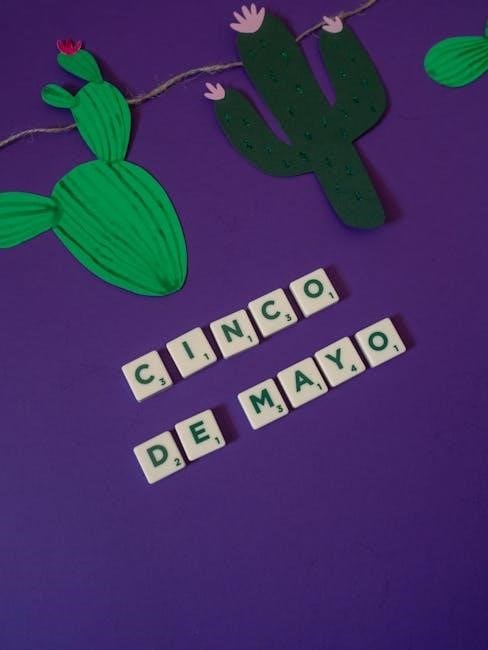Mexican spirit guides embody the essence of cultural heritage‚ serving as protectors and companions; They bridge the physical and spiritual realms‚ offering wisdom and connection to ancestors.
1.1. What is a Spirit Guide?
A spirit guide is a supernatural being believed to offer guidance‚ protection‚ and wisdom to individuals. Rooted in Mexican tradition‚ these guides are often seen as ancestral figures or symbolic animals‚ such as the alebrijes‚ which embody spiritual essence. They are thought to connect the physical and spiritual worlds‚ providing insight and comfort. Spirit guides are deeply personal‚ often reflecting an individual’s values‚ heritage‚ or life journey. They may appear in meditative states‚ dreams‚ or through rituals‚ serving as companions on one’s spiritual path. Their role is to inspire growth‚ clarity‚ and balance‚ helping individuals navigate life’s challenges. In Mexican culture‚ these guides are celebrated for their ability to bridge the mundane and the divine‚ fostering a sense of unity and purpose.
1.2. Cultural Significance in Mexico
Mexican spirit guides hold profound cultural significance‚ deeply rooted in the country’s indigenous beliefs and Catholic traditions. These guides are often seen as intermediaries between the living and the dead‚ playing a vital role in rituals and daily life. The celebration of Día de los Muertos highlights this connection‚ as families honor deceased loved ones‚ believing their spirits return to offer guidance. Folk art‚ such as alebrijes‚ symbolizes these guides‚ embodying the beauty and mystery of Mexican culture. Spirit guides are not just spiritual entities but also symbols of heritage‚ reflecting the resilience and faith of the Mexican people. Their presence in art‚ traditions‚ and storytelling underscores their importance in preserving cultural identity and fostering a sense of community and spiritual harmony.

Folk Art and Spirituality
Mexican folk art‚ like alebrijes‚ serves as vibrant symbols of spirituality‚ embodying the connection between the physical and spiritual worlds. These colorful creations inspire meditation and reflection‚ bridging the divine and human realms.
2.1. Alebrijes: Colorful Spirit Animals
Alebrijes are vibrant‚ handcrafted sculptures depicting fantastical animals‚ blending mythology and nature. Originating from Mexican folk art‚ these intricate pieces are believed to serve as spirit guides‚ connecting the physical and spiritual realms. Each alebrije is uniquely designed‚ often symbolizing protection‚ wisdom‚ or transformation. They are crafted with meticulous detail‚ using bright colors and patterns to represent the beauty and mystery of Mexican culture. Alebrijes are not only artistic expressions but also spiritual tools‚ used in meditation and reflection to guide individuals toward inner peace and enlightenment. Their presence in homes and sacred spaces signifies a deep connection to heritage and the spiritual world. As symbols of resilience and creativity‚ alebrijes have become iconic representations of Mexico’s rich cultural identity.
2.2. Symbolism in Mexican Folk Art
Mexican folk art is rich in symbolism‚ reflecting deep cultural and spiritual beliefs. Common motifs include animals‚ plants‚ and natural elements‚ each carrying specific meanings tied to spirituality and daily life. For instance‚ the eagle symbolizes strength and vision‚ while the serpent represents renewal and wisdom. Bright colors are used to evoke emotions and signify life’s vibrancy. These symbols often appear in art forms like pottery‚ textiles‚ and sculptures‚ serving as bridges between the physical and spiritual worlds. They also reflect the connection to indigenous traditions and the celebration of life and death. Through these symbols‚ Mexican folk art preserves cultural identity and communicates profound spiritual truths‚ making it a vital part of heritage and daily rituals.
The Day of the Dead (Día de los Muertos)
A vibrant celebration honoring the deceased‚ Día de los Muertos connects the living with departed souls through altars‚ rituals‚ and colorful art‚ believing spirits return to visit.
3.1. Traditions and Celebrations
Día de los Muertos is a vibrant celebration honoring the deceased‚ blending indigenous and Catholic traditions. Families create elaborate altars‚ or ofrendas‚ adorned with photographs‚ flowers‚ candles‚ and favorite items of loved ones. Marigold flowers‚ known as “flowers of the dead‚” are used to guide spirits home. Traditional foods like pan de muerto and mole are prepared‚ while parades and decorations fill the streets with color and life. The celebration occurs on November 1st and 2nd‚ with the first day dedicated to children and the second to adults. These rituals reflect a deep connection to ancestors‚ believing their spirits return to visit. The festivities are a testament to Mexico’s rich cultural heritage‚ blending grief with joy and reverence for life.
3.2. Honoring Ancestor Spirits
Honoring ancestor spirits is central to Mexican spirituality‚ particularly during Día de los Muertos. Families create altars with marigold flowers‚ candles‚ photographs‚ and offerings to guide spirits home. They believe ancestors return to visit‚ and these offerings symbolize love and respect. Traditional foods‚ incense‚ and decorations are used to welcome them‚ creating a bridge between worlds.
Visiting cemeteries to clean and decorate graves is a vital tradition‚ often accompanied by music‚ storytelling‚ and feasts. This practice reflects a deep connection to heritage‚ emphasizing that ancestors continue to influence daily life. The celebrations blur the line between mourning and joy‚ celebrating the enduring bond with loved ones who have passed.

Indigenous Influences on Spirit Guides
Mexican spirit guides are deeply rooted in indigenous traditions‚ blending shamanic practices and natural wisdom to connect with ancestral energies and the spiritual realm effectively.
4.1. Native Beliefs and Traditions
Native beliefs in Mexico emphasize a deep connection with nature and ancestors‚ viewing spirit guides as intermediaries between the physical and spiritual worlds. These traditions‚ passed down through generations‚ highlight the importance of rituals‚ ceremonies‚ and the use of sacred objects like alebrijes. Indigenous communities believe that spirit guides offer protection‚ wisdom‚ and healing‚ playing a vital role in daily life and spiritual practices. This rich cultural heritage continues to inspire modern interpretations‚ ensuring the preservation of these ancient beliefs. By honoring these traditions‚ individuals maintain a strong link to their roots and the spiritual realm. The integration of these practices into contemporary spirituality underscores their enduring significance.
4.2. Shamanic Practices and Spirit Guides
Shamanic practices in Mexican culture deeply intertwine with spirit guides‚ who are believed to assist in healing‚ guidance‚ and bridging the physical and spiritual realms. Shamans‚ as spiritual leaders‚ use rituals‚ meditation‚ and sacred objects like alebrijes to communicate with these guides. These practices often involve ceremonies to honor ancestors and seek wisdom‚ reflecting the rich indigenous heritage. Shamans act as intermediaries‚ relying on spirit guides to restore balance and harmony. The use of natural elements and traditional chants further emphasizes the connection to the spiritual world. Through these practices‚ individuals seek healing‚ clarity‚ and a deeper understanding of their life’s purpose. Shamanic traditions remain vital‚ preserving ancient beliefs while offering modern seekers a path to spiritual growth and enlightenment.

Spirit Animals in Mexican Culture
Spirit animals in Mexican culture are vibrant‚ symbolic companions‚ often depicted in art and rituals‚ representing strength‚ wisdom‚ and spiritual connection to heritage and identity.
5.1. What are Spirit Animals?
Spirit animals in Mexican culture are believed to be sacred companions that guide individuals‚ offering wisdom‚ protection‚ and insight. These animals‚ often depicted in vibrant art like alebrijes‚ symbolize strength‚ resilience‚ and spiritual connection. Each animal carries specific meanings—e.g.‚ eagles represent vision‚ while jaguars embody power. They are thought to embody the qualities needed for personal growth and are deeply rooted in indigenous traditions. Spirit animals are not just symbolic but are considered messengers between the physical and spiritual worlds‚ playing a vital role in rituals and daily life. Their presence is celebrated in art‚ storytelling‚ and ceremonies‚ highlighting their importance in Mexican heritage and identity.
5.2. How to Discover Your Spirit Animal
Discovering your spirit animal involves tuning into your intuition and exploring cultural traditions. Meditation and reflection are key practices‚ allowing individuals to connect with their inner selves. Pay attention to recurring animals in your life‚ whether in dreams‚ art‚ or nature‚ as these may signify your spirit animal. Studying the traits and symbolism of animals‚ such as the eagle’s vision or the jaguar’s strength‚ can also guide you. Seeking guidance from spiritual leaders or shamans is another traditional method. Additionally‚ rituals like ceremonies or vision quests are used to reveal spirit animals‚ fostering a deeper understanding of oneself and the spiritual realm. Embrace patience and openness‚ as this journey is deeply personal and meaningful.
5.3. Significance of Spirit Animals in Mexican Tradition
Spirit animals hold profound significance in Mexican tradition‚ serving as sacred companions and symbols of cultural identity. They embody the connection between humans and nature‚ offering guidance‚ protection‚ and wisdom. Rooted in indigenous beliefs‚ spirit animals are believed to carry the essence of ancestors and the divine‚ providing strength and insight in daily life. Their presence is celebrated in art‚ rituals‚ and storytelling‚ where they often represent qualities like courage‚ wisdom‚ and resilience. Alebrijes‚ colorful spirit animal sculptures‚ have become iconic symbols of this tradition‚ reflecting the vibrant spirituality of Mexico. By honoring spirit animals‚ individuals align with their heritage and deepen their understanding of the spiritual world‚ fostering a sense of unity and balance within themselves and their communities.

Beliefs and Practices Surrounding Spirit Guides
Mexican beliefs emphasize rituals‚ altars‚ and offerings to honor spirit guides‚ fostering connection with ancestors and the spiritual realm through meditation and sacred ceremonies.
6.1. Rituals and Ceremonies
Mexican rituals and ceremonies honoring spirit guides often involve altars adorned with flowers‚ candles‚ and offerings. Cleansing rituals‚ such as burning copal incense‚ purify the space for spiritual connection. Alebrijes‚ colorful spirit animals‚ are sometimes included in these rites. During the Day of the Dead‚ families create elaborate altars to welcome ancestor spirits‚ symbolizing love and remembrance. These practices reflect a deep belief in the interconnection of worlds and the guidance offered by spirit guides. Rituals are performed to seek protection‚ wisdom‚ and balance‚ emphasizing the importance of community and tradition in spiritual life.
6.2. The Role of Altars and Offerings
Altars and offerings are central to connecting with Mexican spirit guides‚ serving as a bridge between the physical and spiritual realms. These sacred spaces are meticulously arranged with items like marigold flowers‚ candles‚ photographs‚ and traditional foods‚ creating a welcoming environment for ancestor spirits. Offerings symbolize respect‚ gratitude‚ and the desire for guidance‚ reflecting the deep bond between the living and the deceased. Personalized elements‚ such as favorite items of the departed‚ highlight the intimate nature of these rituals. The act of creating altars strengthens spiritual ties‚ fostering a sense of unity and continuity. Through these offerings‚ individuals seek to honor their heritage and maintain a meaningful dialogue with their spirit guides‚ enriching their spiritual journey and cultural identity.
6.3. Communication with Spirit Guides
Communication with Mexican spirit guides involves rituals‚ meditation‚ and prayer‚ fostering a deep connection with the spiritual realm. Through these practices‚ individuals seek guidance‚ wisdom‚ and healing. Spirit guides often manifest through symbols‚ dreams‚ or natural elements‚ offering subtle yet profound messages. Rituals‚ such as burning copal incense or reciting traditional prayers‚ create a sacred space for dialogue. Many believe that spirit animals‚ like alebrijes‚ serve as messengers‚ bridging the physical and spiritual worlds. This communication is rooted in mutual respect and reciprocity‚ emphasizing the importance of honoring ancestors and the divine. By engaging with these practices‚ individuals cultivate a meaningful relationship with their spirit guides‚ enriching their spiritual journey and cultural heritage.
Modern Interpretations of Spirit Guides
Communication with Mexican spirit guides involves rituals‚ meditation‚ and prayer‚ fostering a deep connection with the spiritual realm. Through these practices‚ individuals seek guidance‚ wisdom‚ and healing. Spirit guides often manifest through symbols‚ dreams‚ or natural elements‚ offering subtle yet profound messages; Rituals‚ such as burning copal incense or reciting traditional prayers‚ create a sacred space for dialogue. Many believe that spirit animals‚ like alebrijes‚ serve as messengers‚ bridging the physical and spiritual worlds. This communication is rooted in mutual respect and reciprocity‚ emphasizing the importance of honoring ancestors and the divine. By engaging with these practices‚ individuals cultivate a meaningful relationship with their spirit guides‚ enriching their spiritual journey and cultural heritage.
7.1. Contemporary Use in Spirituality
Modern spirituality has embraced Mexican spirit guides as symbols of cultural identity and personal growth. Many individuals now incorporate these guides into meditation practices‚ seeking connection with ancestral wisdom. Workshops and retreats focused on discovering spirit animals‚ like alebrijes‚ have gained popularity worldwide. Digital platforms and communities also offer spaces to explore these traditions‚ blending ancient beliefs with contemporary practices. The integration of spirit guides into daily life reflects a growing interest in holistic spirituality and cultural heritage. By honoring these traditions‚ people find meaning and purpose‚ bridging the past with the present. This modern interpretation highlights the enduring relevance of Mexican spirit guides in fostering personal and spiritual transformation.
7.2. Integration into Modern Practices
Mexican spirit guides are now being integrated into modern spiritual practices‚ blending tradition with contemporary lifestyles. Workshops and online courses teach individuals how to connect with their spirit animals‚ such as alebrijes‚ through meditation and reflection. Digital art and social media platforms showcase these guides‚ making them accessible to a global audience. Many modern practitioners incorporate rituals‚ like setting up altars and offering ceremonies‚ into their daily routines. This fusion of ancient beliefs with modern spirituality highlights the adaptability of Mexican traditions. By embracing these practices‚ individuals seek personal growth‚ emotional healing‚ and a deeper connection to their cultural roots. The integration of spirit guides into modern life reflects a growing appreciation for heritage and holistic well-being.
7.3. Cultural Revival and Spirituality
Mexican spirit guides are at the heart of a cultural revival‚ reigniting interest in traditional spirituality. This resurgence is driven by a desire to reconnect with ancestral roots and honor indigenous heritage. Modern spiritual seekers are drawn to the symbolism of alebrijes and the rituals of the Day of the Dead‚ embracing these practices as a way to heal and find meaning. Workshops‚ art exhibits‚ and community events celebrating these traditions are flourishing‚ making them more accessible. This revival not only preserves cultural legacy but also fosters a sense of identity and belonging. By embracing these spiritual practices‚ individuals are contributing to the revitalization of Mexico’s rich cultural tapestry while finding personal enlightenment. The blend of tradition and contemporary spirituality highlights the timeless relevance of these guides in modern life.
The Spiritual Realm in Mexican Culture
Mexican culture deeply honors the spiritual realm‚ where ancestors and spirit guides connect the living with the divine. Vibrant traditions and rituals celebrate this sacred bond.
8.1. Understanding the Spiritual World
Mexican spirituality intertwines the physical and metaphysical‚ viewing life as a journey between realms. The spiritual world is believed to influence daily existence‚ offering guidance and wisdom through ancestors and guides. Rituals like those in Day of the Dead reflect this connection‚ honoring deceased loved ones who continue to play active roles in the lives of the living. This belief system fosters a deep respect for nature‚ symbols‚ and the cyclical nature of life and death. By understanding this spiritual framework‚ one gains insight into the harmonious relationship between the material and the divine in Mexican culture.
8.2. Interactions Between Worlds
In Mexican spirituality‚ interactions between the physical and spiritual worlds are deeply intertwined. Rituals‚ ceremonies‚ and offerings serve as bridges‚ allowing communication with ancestors and spirit guides. Altars are central to these practices‚ adorned with items like flowers‚ candles‚ and photographs to honor the deceased. These interactions are believed to provide guidance‚ wisdom‚ and protection‚ fostering a sense of connection and harmony. The Day of the Dead exemplifies this‚ celebrating the return of loved ones’ spirits. Through these exchanges‚ the living seek wisdom‚ while the spiritual world offers solace and insight. This reciprocal relationship enriches daily life‚ emphasizing the continuity of life beyond death and the enduring bonds between generations.
How to Engage with Your Spirit Guide
Meditation and reflection are key practices to connect with your spirit guide. Creating an altar with meaningful items helps establish a dialogue‚ fostering balance and wisdom.
9.1. Meditation and Reflection Practices
Meditation and reflection are essential for connecting with Mexican spirit guides. These practices help quiet the mind and open the heart to spiritual communication. Begin by creating a sacred space‚ free from distractions‚ where you can focus on your intentions. Smudging with traditional herbs like copal or sage can purify the environment and invite positive energy. Close your eyes and take deep‚ intentional breaths to center yourself. Reflect on your life‚ challenges‚ and desires‚ asking your spirit guide for guidance. Listen for subtle insights or sensations‚ as these may be signs of their presence. Regular meditation fosters a deeper relationship with your spirit guide‚ enhancing intuition and clarity. Over time‚ this practice becomes a powerful tool for navigating life’s journey with spiritual support.
By dedicating time to these practices‚ you honor both your spirit guide and your own spiritual growth.
9.2. Seeking Guidance from Spirit Guides
Seeking guidance from Mexican spirit guides involves rituals that honor their wisdom and presence. Altars are often used‚ adorned with offerings like flowers‚ candles‚ and traditional foods to create a sacred space for communication. Many turn to spirit animals‚ such as alebrijes‚ which symbolize protection and guidance‚ believing they carry messages from the spiritual realm. Practitioners may also use meditation or shamanic practices to connect with these guides‚ seeking clarity on life’s challenges. The belief is that spirit guides offer insights and strength‚ helping individuals navigate their paths. This practice is deeply rooted in cultural heritage‚ emphasizing the importance of respecting and honoring these spiritual mentors. By engaging with these traditions‚ one can foster a meaningful relationship with their spirit guide‚ leading to personal growth and spiritual fulfillment.
Cultural Significance and Heritage
Mexican spirit guides are deeply rooted in cultural heritage‚ symbolizing a connection to indigenous traditions and ancestral wisdom. They preserve history and foster community unity.
10.1. Preserving Traditions and Beliefs
Preserving traditions and beliefs is crucial in maintaining the cultural fabric of Mexican spirit guides. These practices‚ passed down through generations‚ ensure the continuity of spiritual and communal heritage. By honoring ancestors and their teachings‚ individuals strengthen their connection to the divine and the community. Rituals‚ ceremonies‚ and storytelling play vital roles in keeping these traditions alive‚ allowing future generations to understand and embrace their roots. The integration of indigenous beliefs with modern practices highlights the adaptability of these customs‚ ensuring their relevance in contemporary times. This preservation not only safeguards cultural identity but also fosters a sense of belonging and continuity among the people.
10.2. The Role of Community in Spirituality
The role of community in Mexican spirituality is profound‚ serving as a vital support system for individuals seeking guidance from spirit guides. Shared rituals‚ ceremonies‚ and celebrations foster a sense of unity‚ reinforcing the belief that spiritual journeys are not solitary but collective experiences. Communities often gather to honor ancestors‚ share stories‚ and participate in traditions that strengthen spiritual connections. This collective energy amplifies personal intentions and creates a nurturing environment for healing and growth. The community acts as a bridge between the physical and spiritual worlds‚ offering wisdom‚ encouragement‚ and a shared understanding of the mystical. Through this communal approach‚ individuals find strength‚ resilience‚ and a deeper connection to their cultural and spiritual heritage.
Comments